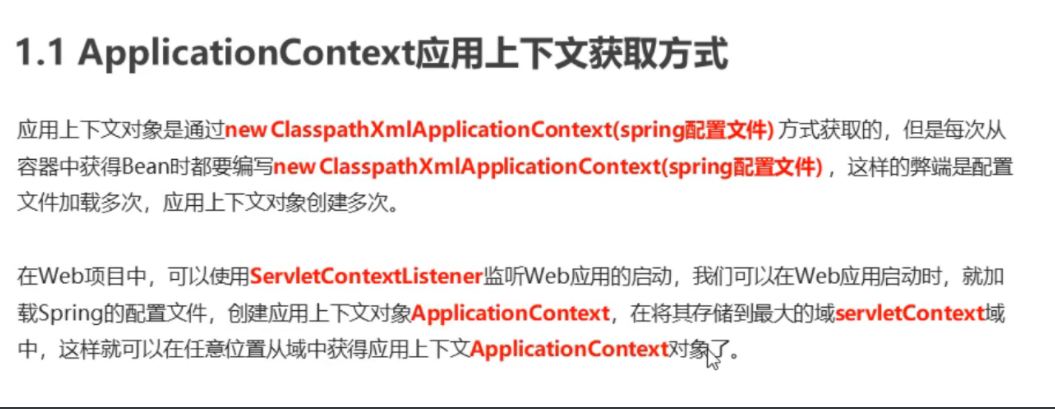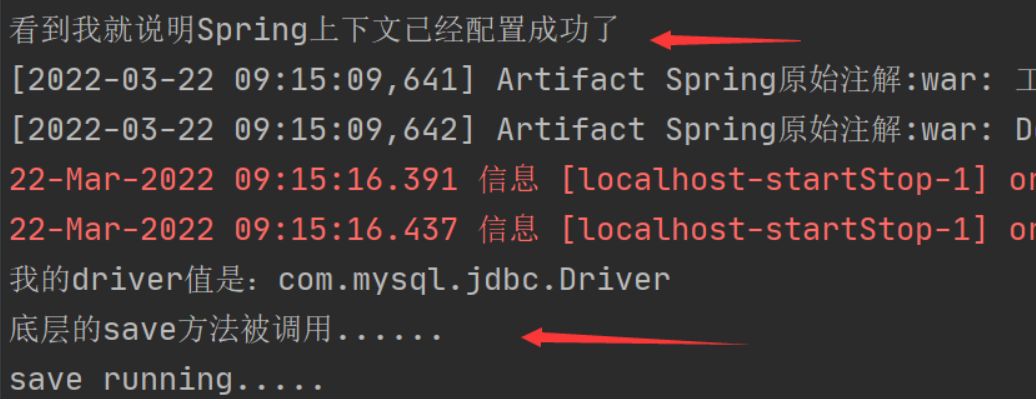6、Spring集成web环境
-
我先准备下web的环境(Servlet)
-
导入Servlet依赖
-
<dependency>
<groupId>javax.servlet</groupId>
<artifactId>javax.servlet-api</artifactId>
<version>3.1.0</version>
</dependency> -
创建web
-
运行效果
-

2、ApplicationContext应用上下文获取方式
2.1、原始方法的弊端
-
我们刚刚创建了web环境下的servlet充当controller层,但是原始环境下,我们想要使用我们在spring容器中创建的对象,依旧需要加载配置文件和getBean()获取到我们想要的对象类型
-
前端发送过来的请求不止一个,如果有多个请求发送过来,那么我们对于配置类的加载就需要多次加载,异常的麻烦
-
我们依旧加载了ApplicationContext app = new AnnotationConfigApplicationContext(SpringConfigurataion.class);
-
和使用getBean()获取我们的UserService的对象
-
2.2、解决办法--图解

3、自定义Context-Linstener(解决2.2中问题的实践环节)
3.1、创建我们的监听器类--监听ServletContext
-
需要实现ServletContextListener类,重写他的两个方法
public class ContexLoadListener implements ServletContextListener {
3.2、方法简述
-
contextInitialized:ServletContex被创建的时候调用,我们可以在这个方法内部创建我们的Spring应用上下文的对象(相当于加载我们的配置类或者配置文件)
-
contextDestroyed:ServletContex对象销毁的时候调用,不讲,暂时没用
3.3、方法实践
-
在ServletContext对象创建的时候加载我们的配置类
-
创建完毕之后获取到ServletContex对象,并将我们Spring应用上下文的对象存储到其中(app存到ServletContex中)
public class ContexLoadListener implements ServletContextListener {
3.4、配置到Tomcat服务器当中
-
打开我们的web.xml中
-
创建监听器类的全限定名放入其中
-
<listener>
<!-- 将我们配置的监听器类的全限定名放在这里 -->
<listener-class>com.waves.Listener.ContexLoadListener</listener-class>
</listener>
3.5、重新配置web层并重新设置我们的方法

3.4、代码优化(ApplicationContext app = (ApplicationContext) servletContext.getAttribute("app"))
-
这行代码是耦合死的,如何解决?
-
创建一个工具类,这个工具类返回一个ApplicationContext对象,这样我们在web层启动配置类的时候就不需要记住那个“app”的前缀了
-
创建一个WebServletContextUtil
-
public class WebServletContextUtil {
// 设置一个静态方法,该方法返回一个ApplicationContext对象
public static Object getApplicationContext(ServletContext context) {
return context.getAttribute("app");
}
} -
重新改造下我们的web层代码
-
4、使用Spring为我们封装的工具来获取Spring应用上下文对象

4.1、使用Spring提供的上下文工具








【推荐】还在用 ECharts 开发大屏?试试这款永久免费的开源 BI 工具!
【推荐】国内首个AI IDE,深度理解中文开发场景,立即下载体验Trae
【推荐】编程新体验,更懂你的AI,立即体验豆包MarsCode编程助手
【推荐】轻量又高性能的 SSH 工具 IShell:AI 加持,快人一步
· 如何在 .NET 中 使用 ANTLR4
· 后端思维之高并发处理方案
· 理解Rust引用及其生命周期标识(下)
· 从二进制到误差:逐行拆解C语言浮点运算中的4008175468544之谜
· .NET制作智能桌面机器人:结合BotSharp智能体框架开发语音交互
· Cursor预测程序员行业倒计时:CTO应做好50%裁员计划
· 想让你多爱自己一些的开源计时器
· 大模型 Token 究竟是啥:图解大模型Token
· 用99元买的服务器搭一套CI/CD系统
· 当职场成战场:降职、阴谋与一场硬碰硬的抗争